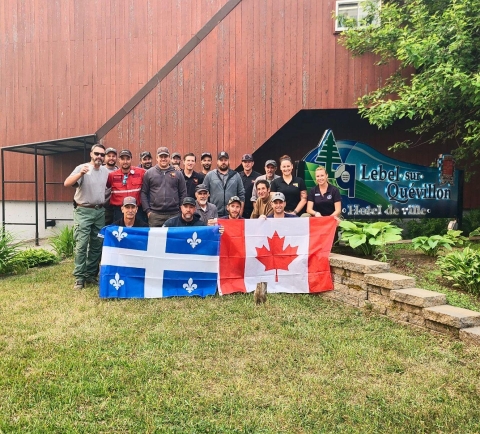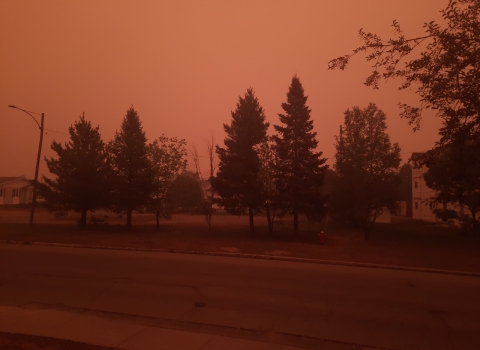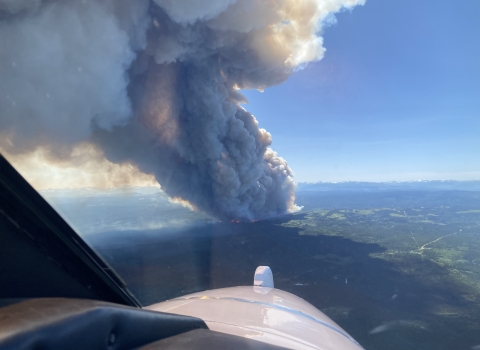After almost 4,700 miles, Eric Johnson, the Assistant Fire Management Officer for the Hawaiian and Pacific Islands for the U.S. Fish and Wildlife Service (USFWS), finally arrived in Canada. Landing at the airport, he made his way to Lebel-sur-Quévillon, a small town of about 2,000 people, in Quebec. Lebel-sur-Quévillon is where the Incident Command Post was established to manage the Lebel-sur-Quévillon Complex, which consisted of 17 wildfires. The complex, at about 600,000 acres at the time of his arrival, would expand to consume 1.5 million acres by the end of his assignment.
Except for fire personnel, the small town of Lebel-sur-Quévillon was deserted, having been evacuated prior to Johnson’s arrival. Johnson filled the role of Fire Behavior Analyst (FBAN) on the Southwest Area Incident Management Team (IMT) to assist with the wildfire situation in Canada, currently experiencing their worst fire season on record.
As a FBAN, Johnson is responsible for collecting weather data, developing strategic and tactical fire behavior information, predicting fire growth, and interpreting fire characteristics for use by incident overhead (personnel assigned to supervisory positions). All this information is used to inform managers and firefighters about what fire behavior is likely to do over a specific timeframe, typically five days. On wildfire incidents in the United States, Johnson would typically work with an Incident Meteorologist. However, on this assignment, the team did not have one, so he functioned as the onsite weather expert too.
Every assignment has its own set of unique challenges, and this assignment was no different. Quebec’s official spoken language is French. Johnson, who does not speak French, mentions a heartfelt gratitude whenever he encountered a local fluent in English. “My high school French teacher would have been quite disappointed in me,” said Johnson.
“There were times when I would be doing a reconnaissance flight to check on fire activity and the pilot didn’t speak English and I don’t speak French,” shares Johnson, with a laugh. “There was a lot of pointing and gesturing going on.”
At other times, Johnson had access to Google Translate. He found utilizing this software helped him communicate when more than gestures were needed. There was also a bilingual administrator who monitored all the radio traffic at the Incident Command Post to ensure multi-language communications weren’t missed.
“Another challenge I hadn’t anticipated was Canadian, Portuguese and Korean firefighters’ familiarity with the metric system rather than imperial units,” said Johnson. “It was important to translate units of measurement for both audiences. Instead of focusing on finite measurements for fire activity, I tried to focus on more qualitative descriptions of expected fire behavior. So, instead of saying ‘fire will spread at 5 meters per minute with spotting to 1 kilometer, ‘I would say ‘fire transition to crown fire on all flanks by early afternoon, with medium-range spotting to the southwest, likely crossing Belle Rivière south of the boat ramp today’.”
Johnson also needed to decipher differences in Canada’s Fire Behavior Prediction (FBP) system from the U.S. system to determine weather (fuel moisture) and fuel types to apply. There are significant differences to the systems, most important are the way weather (fuel moisture and wind) and fuel models (fuel types) are applied. This required Johnson to do a bit of homework to better understand their system, interpret the data, and make sound predictions to share with fire personnel.
Johnson is used to adjusting to assignments in emergency management. At the time of this interview, he was sitting in an airport in Hawaii traveling to Guam to assist with prioritization and recovery at Guam National Wildlife Refuge, which was impacted by Super Typhoon Mawar in late May of this year.





